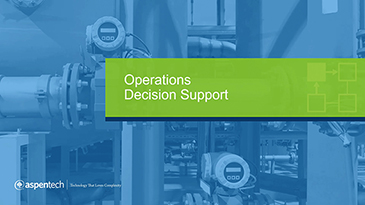Imagine one day your boss comes into your office and tasks you with finding a way to increase production rate through one of your units. The two of you discuss some ways you could make it happen, but you are afraid you are operating near the unit’s limits already.
After she leaves, your head is spinning wondering how you’re going to make this happen. You set your sights on a column that has been a bit of a troublemaker in the past. This column is difficult to optimize because there are so many components and the composition of the feed is changing all the time. You’ve tried to adjust the operating conditions, but any adjustments don’t seem to last because of the constant change in composition. It seems like by the time you figure out the best way to run the column and get it working smoothly again, the feed changes and you’re back at the drawing board.
If you want to optimize your plant, you’re going to have to figure out how to get this column under control. But how?
That’s when you remember seeing some articles on LinkedIn about “digital twins” and “plant digitalization.” You think there must be a way to use these new tools to your advantage… and there is!
AspenTech’s Operations Decision Support can help you optimize operations in real time.
It starts with configuring the models. We need to make sure that the models will make accurate predictions by validating against historical data.
- Offline Decision Support
Once your models are made and validated, you can use them immediately to find optimal operations. As soon as a new composition is known, you can immediately run the model and determine how to set the column. AspenTech clients can already see increased production at this “Offline Decision Support” level, using the model as a digital twin to evaluate decisions in your plant without the risks associated with changing controls. Offline Decision Support requires someone familiar with the model to be around to run it whenever there is a change, however. - Open Loop Online Model
You can connect the model to a real-time data historian and schedule it to run automatically or on-demand, sidestepping the need for an engineer to run the model. You can schedule this “Open Loop Online Model” to run on an interval and tell operators how to set the equipment so that it’s running optimally. Operators can easily see what is happening in the model and monitor the performance of the columns. - Closed Loop Online Model
From here, the next step is to use the digital twin model output and automatically send the results of the optimal operations to the distributed control system (DCS) to adjust the controls. The entire operation of the model becomes a “Closed Loop Online Model” and the operators can watch the interface to see how the column is running and how the model and column are adjusting in real time.
Many of our customers have implemented systems along this range of operations decision support solutions with great success.
- Dow Chemical has implemented closed loop online models across their organization, resulting in benefits of nearly $700 million USD in 9 years.
- Ingenero used a digital twin in an offline decision support application to evaluate a process and helped their customer gain additional processing of 7% of the total plant feed.
- Dowell Technology implemented a digital twin which allows them to evaluate different process options in just 2 days – reduced from 3-4 months, saving at least $3-4 million USD per year.




Leave A Comment